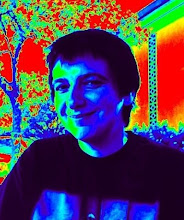My mother had a great secret passion. If you have caught the hints I dropped in previous postings, you already know which.
She had always been the best student at each and every school she attended (for the sake of knowledge only, it is understood). When she was about to finish school and ready to make the crucial decision on a course of higher studies, my grandfather arranged for her to meet his childhood friend, at the time not yet, but soon to become, Nobel laureate. I do not know what conversation took place, but something must have ignited the easily combustible material that constitutes a bright young inquisitive mind. Was it something about the synthesis of macromolecules, about the marvels of polymerization? I do not know. Chemistry became my mothers ever present secretly cultivated life passion.

Why a secret passion and not also a life career? Good question, one that neither I nor, I believe, my mother ever had a clear answer for. Being the bright student she was, she easily won admission, and with flying colors, to the Chemistry program of the then best university in the country, the Polytechnique where the famous chemical scientist himself had studied. She obtained a highly competitive fellowship to support her studies away from home, loved the place and started off distinguishing herself immediately as, needless to say, the best student in the program. She was all set and ready to march on into a bright future of laboratories, experiments, discoveries, passion and wonder.
Very soon and very unexpectedly, she quit the Chemistry program she was enjoying so much and transfered to the Architecture program within the same Polytechnique. It was only thanks to the fact that she immediately became the best student in the other program as well, that she was allowed to maintain her fellowship and continue.
Childhood is a state of captivity we seek at all costs to escape. Often parents fail to realize how badly their offspring need to get rid of their large looming shadows. There is nothing worse parents can do to their grown up children than failing to set them free. She loved Chemistry but could not stand the idea of her father still there breathing on her neck, with his friends, his expectations, his projections. She much preferred to sacrifice the one thing she loved the most and be free, than to remain chained to the umbilical chord of childhood. Her father, who understood the reason behind her choice, did not forgive her. She ran off to her newly chosen destiny and they remained on non-speaking terms for twenty years.

As soon as I was old enough to go to school, my mother started talking to me about Chemistry. I learned how things are made of different elements, and that the varieties of combinations of these ninety something building blocks are responsible for all the different qualities of the things we see: the fact that water is liquid and transparent, the smell of ammonia that spreads around when the cat pees, the fact that certain objects are opaque, shiny, translucent, solid or liquid, it all boils down to these things called molecules. It was the most incredibly wonderful thing I had ever heard, but there was more. There were different bonds between atoms that formed molecules and a way to understand how the physical properties of the different elements recur in families. There was the periodic table. My mother drew for me, using the same large drawing table she used for the architecture blueprints, a giant size reproduction of Mendeleev's periodic table. It occupied the whole stretch of the wall along which my bed stood. I stared at it at night, reading with fascination, atomic number, atomic radius, isotope abundance, melting and boiling points. I noticed that only two of the elements are liquid at ordinary temperature (do you know which ones?). There were other, more mysterious numbers: electronegativity, first ionization energy; and then there was the most wonderful thing of all: electron configuration. Those cryptic codes like 3d^6 4s^2 (that's Iron) or 4d^10 5s (Silver) or 2s^2 2p^3 (Nitrogen) were a code that matched a large drawing my mother had added to the side of the main table, which illustrated schematically a nucleus, surrounded by shells where, she told me, the electrons resided. Some of these orbitals were round (s) some had more complicated shapes (p,d,f). I noticed (I had long hours to look at this thing every night) how p only appeared with atomic number 5 and then again with 13, d only with 21, and then once again with 39. The very last of the transuranic elements were decorated with question marks. Mother told me that we do not really know they are there, but they are expected on the basis of the structure of the shells. What a marvel science was, which could predict such wonders! Other children had guardian angels looking over their sleep. I had guardian atomic shells.

When she saw that I was completely hooked up on the periodic table of the elements, we began to explore the wider world of molecules. That's when I got the most beautiful toy I ever had: a kit to build molecular models.

I would rush to school in the morning, tucking away in the pockets of my coats all the best samples I had built the night before. I showed to everybody the shape of water and ammonia, and when even the molecules of sulphuric acid and nitroglycerine had failed to impress my classmates, I slowly extracted from my pocket the marvel of marvels: the benzene ring! They thought I was showing them some strange bracelet and they showed me bead chains and little mirrors. I was totally baffled.

